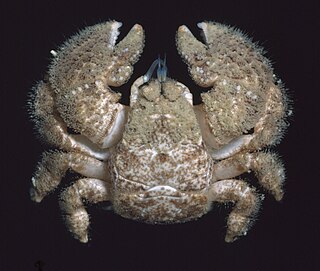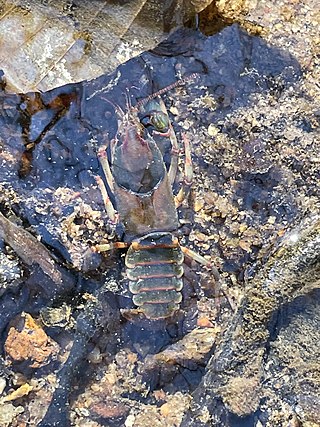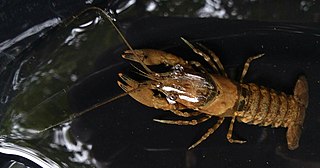
Eucarida is a superorder of the Malacostraca, a class of the crustacean subphylum, comprising the decapods, krill, and Angustidontida. They are characterised by having the carapace fused to all thoracic segments, and by the possession of stalked eyes.

The hairy stone crab is a crab-like anomuran crustacean that lives in the littoral zone of southern Australia from Bunbury, Western Australia, to the Bass Strait. It is the only species in the family Lomisidae. It is 1.5–2.5 cm (0.6–1.0 in) wide, slow-moving, and covered in brown hair which camouflages it against the rocks upon which it lives.
Cambarus chaugaensis, the Chauga crayfish or Chauga River crayfish, is a species of crayfish in the family Cambaridae. It is endemic to the Carolinas in the United States of America. The common and scientific names refer to the Chauga River of South Carolina, where the first specimens were collected.
Cambarus coosawattae, the Coosawattae crayfish, is a species of crayfish in the family Cambaridae. It is endemic to Georgia. The common name refers to the Coosawattee River, with the original specimens being collected in the Cartecay River which combines with another river to form the Coosawattee.
Cambarus cymatilis, the Conasauga blue burrower is a species of burrowing crayfish in the family Cambaridae. It is native to Tennessee and Georgia in the United States. The common name refers to the Conasauga River.
Cambarus harti, the Piedmont blue burrower, is a species of burrowing crayfish in the family Cambaridae. It is endemic to Georgia in the United States. The common name refers to the Piedmont plateau region.

Cambarus howardi, the Chattahoochee crayfish, is a species of crayfish in the family Cambaridae. It is found in North America. The common name refers to the Chattahoochee River, where the first specimens were collected.

Cambarus scotti, the Chattooga River crayfish, is a species of crayfish in the family Cambaridae. It is endemic to Alabama and Georgia. The common name refers to the Chattooga River. The original specimens were collected from Clarks Creek in Chattooga County.
Cambarus spicatus, the Broad River spiny crayfish is a species of crayfish in the family Cambaridae. It is endemic to the Carolinas in the United States of America. The common name refers to the Broad River.
Euastacus diversus is a species of southern crawfish in the family Parastacidae.
Horton Holcombe Hobbs Jr. was an American taxonomist and carcinologist, specialising in freshwater decapods. He was also a capable artist, musician, cook and botanist.

Eubrachyura is a group of decapod crustaceans comprising the more derived crabs. It is divided into two subsections, based on the position of the genital openings in the two sexes. In the Heterotremata, the openings are on the legs in the males, but on the sternum in females, while in the Thoracotremata, the openings are on the sternum in both sexes. This contrasts with the situation in other decapods, in which the genital openings are always on the legs. Heterotremata is the larger of the two groups, containing the species-rich superfamilies Xanthoidea and Pilumnoidea and all the freshwater crabs. The eubrachyura is well known for actively and constantly building its own burrows. The fossil record of the Eubrachyura extends back to the Cretaceous; the supposed Bathonian representative of the group, Hebertides jurassica, ultimately turned out to be Cenozoic in age.

Prawn is a common name for small aquatic crustaceans with an exoskeleton and ten legs, some of which are edible.

Crustaceans belong to the subphylum Crustacea, and form a large, diverse group of arthropods including decapods, seed shrimp, branchiopods, fish lice, krill, remipedes, isopods, barnacles, copepods, opossum shrimps, amphipods and mantis shrimp. The crustacean group can be treated as a subphylum under the clade Mandibulata. It is now well accepted that the hexapods emerged deep in the Crustacean group, with the completed group referred to as Pancrustacea. The three classes Cephalocarida, Branchiopoda and Remipedia are more closely related to the hexapods than they are to any of the other crustaceans.
Ogaridiscus subrupicola, common name the southern tightcoil, is a species of air-breathing land snail, a terrestrial pulmonate gastropod in the family Zonitidae. No subspecies are listed in the Catalog of Life.

Faxonius erichsonianus is a species in the family Cambaridae ("crayfishes"), in the order Decapoda. A common name for Faxonius erichsonianus is reticulate crayfish. Faxonius erichsonianus is found in the south eastern United States of America.

Persephona mediterranea, the mottled purse crab, is a species of true crab in the family Leucosiidae. It is found in the western Atlantic Ocean.

Procambarus acutus, the white river crayfish, is a species of crayfish in the family Cambaridae. It is found in North America and Europe.

Taliepus is a genus of kelp and spider crabs in the family Epialtidae. There are at least three described species in the genus Taliepus.










